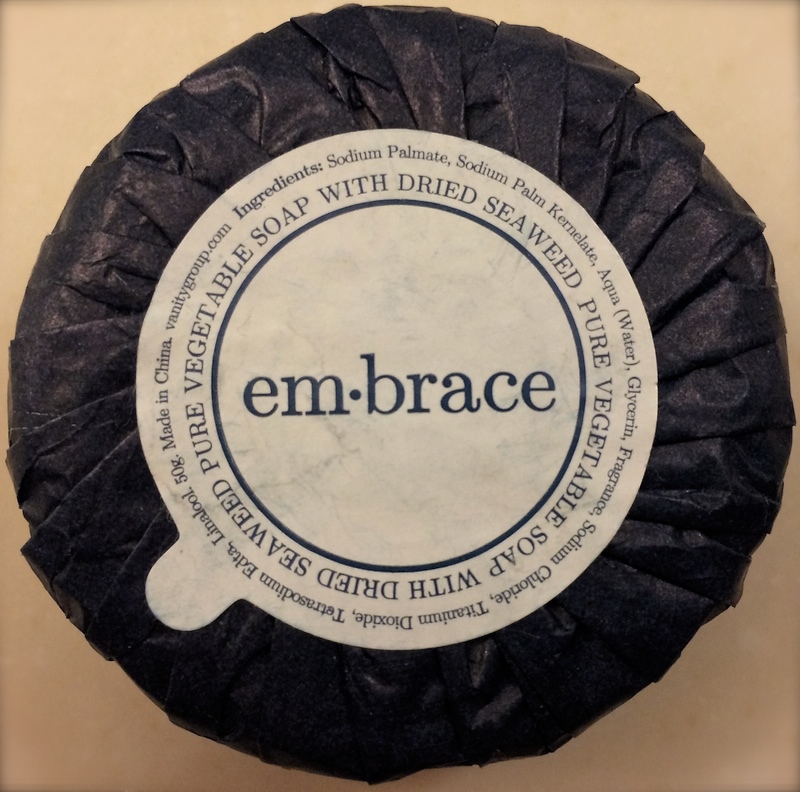I was recently in a hotel in Singapore and was delighted to find what looked like a nice soap alternative. I was also really happy to see that the packaging was made of paper and not plastic. Unfortunately, closer examination didn’t make me too happy. It’s worth studying the label and not just be fooled by the first impression.

As you can see from the label above, it appears to be marketed towards people who might be concerned about all the chemicals in unnatural soaps (for more information see Detoxification Through Natural Personal Care Products – Step 3). The large text around the circle says “Pure vegetable soap with dried seaweed”. That sounds good. It’s what I like to hear.
It’s worth studying the label (and the fine print)
But then I read the finer print around that and I found a different, and worrying, story. Listed below are four of the ingredients that worry me.
1. Tetrasodium EDTA
I remember looking into something called EDTA recently, so the name “Tetrasodium EDTA” caught my attention. One informational webpage on Tetrasodium EDTA can be found on the website “Truth in Aging” and some of the important comments on this page are;
- they say this chemical is added to soaps to “reduce soap scum and improve lather and foaming action” – nothing important for getting you clean, but important to make it seem more like what we think a soap should be like
- “Tetrasodium EDTA a low to moderate hazard ingredient”
- “concerns regarding cancer, enhanced skin absorption, organ system toxicity and irritation”
- “Some studies showed reproductive and developmental effects following oral exposure to large doses”
So, it’s an added chemical that doesn’t help clean you and it carries potential health concerns. I don’t need any more information than that to realise that I’d rather not have it in my soaps.
2. Titanium dioxide
At least Titanium dioxide is a naturally occurring mineral, but would you take every mineral you find in the ground and rub it onto you skin? In some products titanium dioxide is used to reflect UV rays as a sunscreen, and in soaps it’s used primarily as a pigment and “it is a mostly aesthetic ingredient that makes products appear more white or opaque” (see here for an example of it’s effect). Then, of course, there is debate on “whether these particles are small enough to penetrate the skin and become a possible carcinogenic”.
Again, it’s added to soap only to help with it’s appearance and it’s possibly not good to put on your skin. I’d rather not have it in my soaps.
3. Sodium palm kernelate
Palm oil is a natural substance so, in essence that’s good but “to make way for Palm plantations millions of hectares of tropical ecosystems such as rainforest, grasslands, swamps and peat bogs throughout South America, Southeast Asia, the Pacific and Africa are being cleared, drained and burned annually” (see this web page). They’re not doing this because of soaps but because palm oil is used as cooking oil, in margarine, in processed food and is now part of the bio-fuel industry.
Sodium palm kernelate “is palm oil that has been saponified (chemical interaction of fatty acids and alkali)”. It appears that it’s commonly used because it’s cheap and easily accessible, not because it’s ideal to use in soaps.
It doesn’t appear that there’s any huge issue with sodium palm kernelate except to worry about the sustainability of its methods of agriculture.
4. Fragrance
I always worry when one of the ingredients is listed as “fragrance”. That gives me no idea what the ingredient is. It could be anything and maybe they’re trying to hide something that’s dangerous.
If you think about it for a moment, a fragrance is only added to make something smell nicer. It doesn’t make it any nicer as a soap, it just makes it smell nicer. And it’s almost an admission that the product doesn’t really smell very nice without the fragrance. They’re admitting that if they didn’t add a fragrance, you probably wouldn’t want to buy the soap. I’d prefer to buy a soap that just smells nice without a fragrance.
To make things worse, fragrances often prove to be problems for our health as well. As a simple example, have a look at this report “Prevalence of Fragrance Sensitivity in the American Population” by two doctors in the U.S.
It’s worth studying the label
I was a bit fooled with the initial advertising of this soap. It sounded good and nice and I was happy to find it in a hotel bathroom. Then I remembered the importance of studying the label and I saw many ingredients that are a concern and not really needed in a soap.
There’s no real point arguing about whether an ingredient is really bad for us or not. If it’s not really needed to be in a soap then I’d rather it not be there. Simplicity is a good rule of thumb. Why overcomplicate things?
Simple, natural soaps prepared with methods that are kind to the world are what I’d like.
Related Links – It’s worth studying the label
- Tetrasodium EDTA – http://www.truthinaging.com/ingredients/tetrasodium-edta
- Titanium Dioxide – http://thesoapbar.blogspot.sg/2011/01/titanium-dioxide-is-it-safe-re-post.html
- Sodium Palm Kernelate – http://www.andalucia-naturalsoap.com/Palm-Oil-Free.html
- Fragrance – http://co-soap.com/blog/fragrance-dangers-the-slippery-slope-of-scented-soaps/
- Prevalence of Fragrance Sensitivity in the American Population
- Finding Lovely, Natural Soaps
- Rocky Mountain Soap Company
I just bought what I thought was a natural, rather pricey soap and was surprised to read the ingredients. The Pure goat’s milk soap has goat milk as it’s 5th ingredient.
Ingredients are; sodium palmate, sodium cocotte and/or Palm kernalate, water, glycerine, Capre Lac (goat’s milk), disodium cocoyl glutamate, sodium cocoyl, so odium cocoyl theoninate, sodium chloride, pentasodium pentatate, tetra sodium etidronate.
This one is the unfragranced one. The other dozen or more soaps have “fragrance” before the goat milk and several more ingredients, many with titanium dioxide.
What are your thoughts on this?